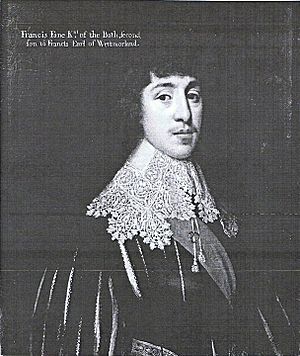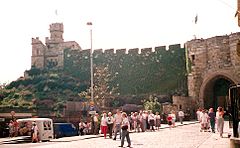Siege of Lincoln facts for kids
Quick facts for kids Siege of Lincoln |
|||||||
|---|---|---|---|---|---|---|---|
| Part of the First English Civil War | |||||||
 Royalist garrison commander, Sir Francis Fane |
|||||||
|
|||||||
| Belligerents | |||||||
| Commanders and leaders | |||||||
| Sir Francis Fane Charles Dallison |
Earl of Manchester Oliver Cromwell |
||||||
| Strength | |||||||
| 2,000 foot | 6,000 foot and horse | ||||||
| Casualties and losses | |||||||
| 50 killed 750-900 captured |
8 killed 40 wounded |
||||||
The Siege of Lincoln was an important battle during the First English Civil War. It happened from May 3 to May 6, 1644. During this time, the town of Lincoln was attacked by the Parliamentarian army. This army was led by the Earl of Manchester.
On the first day, the Parliamentarians took control of the lower part of the town. The Royalist defenders then moved into the stronger upper town. This area included Lincoln Castle and Lincoln Cathedral. The siege ended just four days later. Parliamentarian soldiers stormed the castle and captured the Royalist leader, Sir Francis Fane. They also captured the rest of his soldiers.
Why Was Lincoln Important?
The English Civil War was a fight between two main groups. One group was the Royalists, who supported King Charles I. The other group was the Parliamentarians, who supported the Parliament. Lincoln was a key town because of its location and strong defenses. Both sides wanted to control it.
In early 1644, the Parliamentarians were trying to take Newark-on-Trent, another Royalist stronghold. At the same time, a combined Parliamentarian and Scottish army was attacking York. King Charles I sent his nephew, Prince Rupert, to help the Royalists in these areas.
Prince Rupert managed to help Newark. This allowed the Royalists to take control of the area, including Lincoln. They set up a group of soldiers in Lincoln on March 23, 1644. They also found many muskets (guns) there.
However, Prince Rupert decided he couldn't hold onto all the places he had won. So, he left a group of soldiers in Lincoln, led by Sir Francis Fane. Meanwhile, the Parliamentarian army, led by the Earl of Manchester, saw a chance to fight back.
Manchester's army marched to Lincoln and arrived on May 3, 1644.
The Siege Begins
Manchester's army had about 6,000 soldiers. The Royalist group in Lincoln had about 2,000 soldiers. On May 3, the Parliamentarians successfully captured parts of the lower town. The Royalists then moved back to their stronger defenses in the upper town. This area included Lincoln Castle and Lincoln Cathedral.
The attack stopped the next day because of heavy rain. The ground became too muddy and slippery to fight.
Oliver Cromwell, a famous Parliamentarian leader, made sure his cavalry (soldiers on horseback) protected the siege. He wanted to stop any help from reaching the Royalists. On May 5, Cromwell's soldiers were ready quickly when they heard that Royalist help was nearby. The Royalist forces, led by Lord Goring, saw that the Parliamentarians were ready and turned back.
Storming the Castle
The Parliamentarians attacked Lincoln Castle on the night of May 6. Their ladders were a bit too short, but they still managed to climb over the walls and get inside the castle. The Royalist soldiers quickly gave up.
The Parliamentarians had only 8 soldiers killed and about 40 wounded. The Royalists lost about 50 soldiers. They also had between 750 and 900 soldiers captured. Among those captured were Sir Francis Fane, the Royalist governor, and Sir Charles Dallison. The Parliamentarians also took eight cannons and many other useful supplies.
What Happened Next?
After their victory, the Parliamentarian soldiers took supplies from the upper town. The leaders in London were very happy and sent their congratulations to Manchester.
Soon after taking Lincoln, Manchester ordered a bridge of boats to be built over the River Trent. Cromwell and his cavalry crossed the river. They chased the Royalist forces, forcing them to escape by swimming across the river.
Cromwell then returned to other towns, where more Scottish cavalry joined him. The Royalists, led by Goring, moved to other areas, taking supplies. The Parliamentarian generals believed that Prince Rupert was planning to help York. So, they kept their cavalry ready in south Yorkshire.
Manchester stayed in Lincoln until about May 22. He then moved his army to join the forces attacking York. He arrived there on June 3. Manchester, along with other Parliamentarian leaders, won a very important battle against Prince Rupert at the Battle of Marston Moor on July 2. This victory was a big turning point in the war.


